MGT100 Assignment: Analyzing Organizational Culture, CSR, and Business
VerifiedAdded on 2022/12/21
|9
|2299
|1
Homework Assignment
AI Summary
This assignment analyzes Michael Watkins' article on organizational culture, exploring its definition, impact, and changeability. The student identifies the main argument, assumptions, and limitations of the research, and then outlines the main conclusions of the article. The assignment connects the article's concepts to themes taught in the MGT100 course, focusing on organizational culture, change, and leadership. Furthermore, it examines a real-world business example (Lego) and its CSR approach, providing justifications and recommendations. The assignment also includes peer-reviewed journal articles on CSR, with APA citations and explanations of their relevance, along with paraphrased and direct quotes from these articles. The student demonstrates an understanding of organizational culture, CSR strategies, and their application in a business context.

Running Head: ORGANIZATION AND MANAGEMENT
Name of the Student:
Name of the University:
Author note:
Name of the Student:
Name of the University:
Author note:
Paraphrase This Document
Need a fresh take? Get an instant paraphrase of this document with our AI Paraphraser
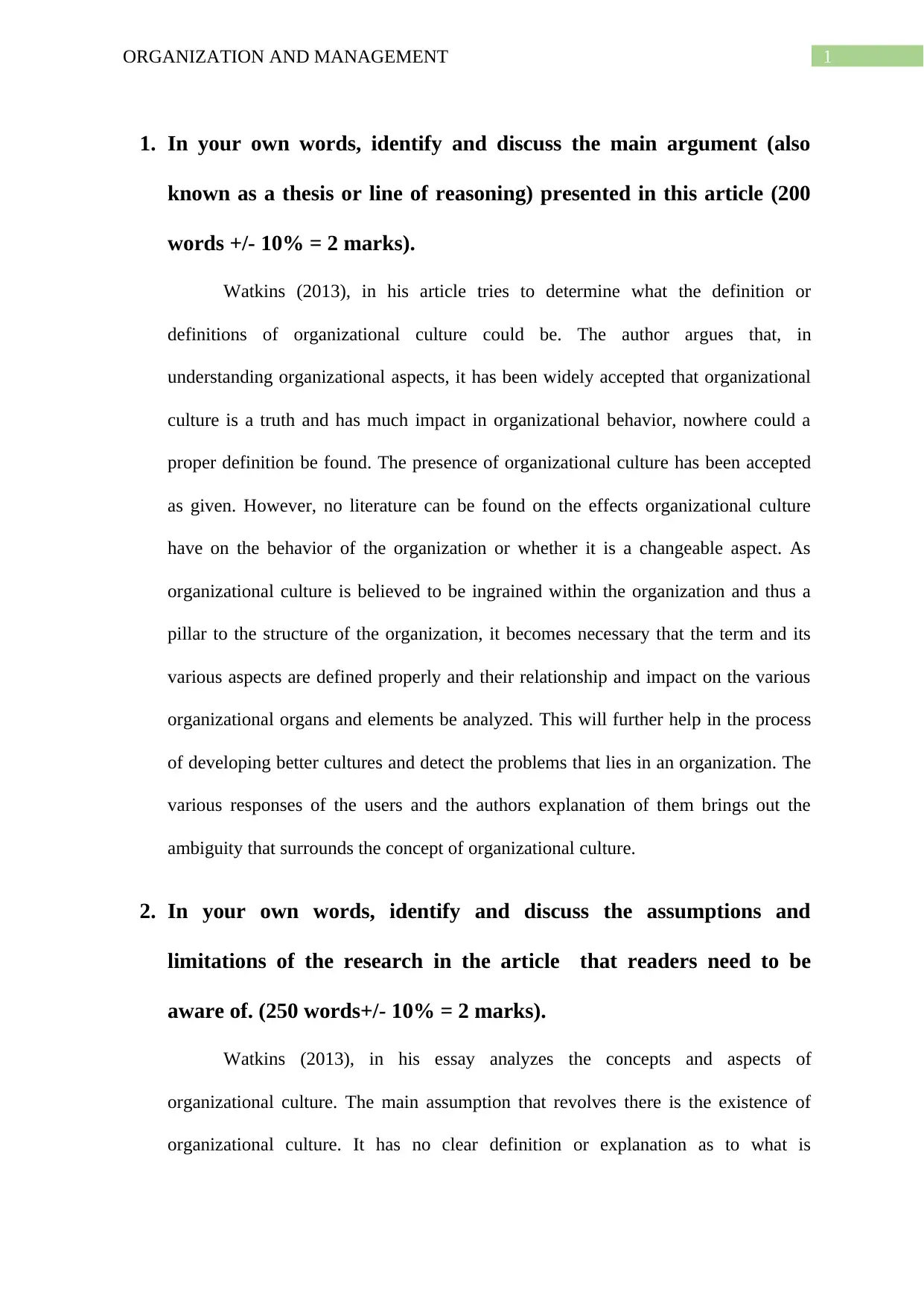
1ORGANIZATION AND MANAGEMENT
1. In your own words, identify and discuss the main argument (also
known as a thesis or line of reasoning) presented in this article (200
words +/- 10% = 2 marks).
Watkins (2013), in his article tries to determine what the definition or
definitions of organizational culture could be. The author argues that, in
understanding organizational aspects, it has been widely accepted that organizational
culture is a truth and has much impact in organizational behavior, nowhere could a
proper definition be found. The presence of organizational culture has been accepted
as given. However, no literature can be found on the effects organizational culture
have on the behavior of the organization or whether it is a changeable aspect. As
organizational culture is believed to be ingrained within the organization and thus a
pillar to the structure of the organization, it becomes necessary that the term and its
various aspects are defined properly and their relationship and impact on the various
organizational organs and elements be analyzed. This will further help in the process
of developing better cultures and detect the problems that lies in an organization. The
various responses of the users and the authors explanation of them brings out the
ambiguity that surrounds the concept of organizational culture.
2. In your own words, identify and discuss the assumptions and
limitations of the research in the article that readers need to be
aware of. (250 words+/- 10% = 2 marks).
Watkins (2013), in his essay analyzes the concepts and aspects of
organizational culture. The main assumption that revolves there is the existence of
organizational culture. It has no clear definition or explanation as to what is
1. In your own words, identify and discuss the main argument (also
known as a thesis or line of reasoning) presented in this article (200
words +/- 10% = 2 marks).
Watkins (2013), in his article tries to determine what the definition or
definitions of organizational culture could be. The author argues that, in
understanding organizational aspects, it has been widely accepted that organizational
culture is a truth and has much impact in organizational behavior, nowhere could a
proper definition be found. The presence of organizational culture has been accepted
as given. However, no literature can be found on the effects organizational culture
have on the behavior of the organization or whether it is a changeable aspect. As
organizational culture is believed to be ingrained within the organization and thus a
pillar to the structure of the organization, it becomes necessary that the term and its
various aspects are defined properly and their relationship and impact on the various
organizational organs and elements be analyzed. This will further help in the process
of developing better cultures and detect the problems that lies in an organization. The
various responses of the users and the authors explanation of them brings out the
ambiguity that surrounds the concept of organizational culture.
2. In your own words, identify and discuss the assumptions and
limitations of the research in the article that readers need to be
aware of. (250 words+/- 10% = 2 marks).
Watkins (2013), in his essay analyzes the concepts and aspects of
organizational culture. The main assumption that revolves there is the existence of
organizational culture. It has no clear definition or explanation as to what is
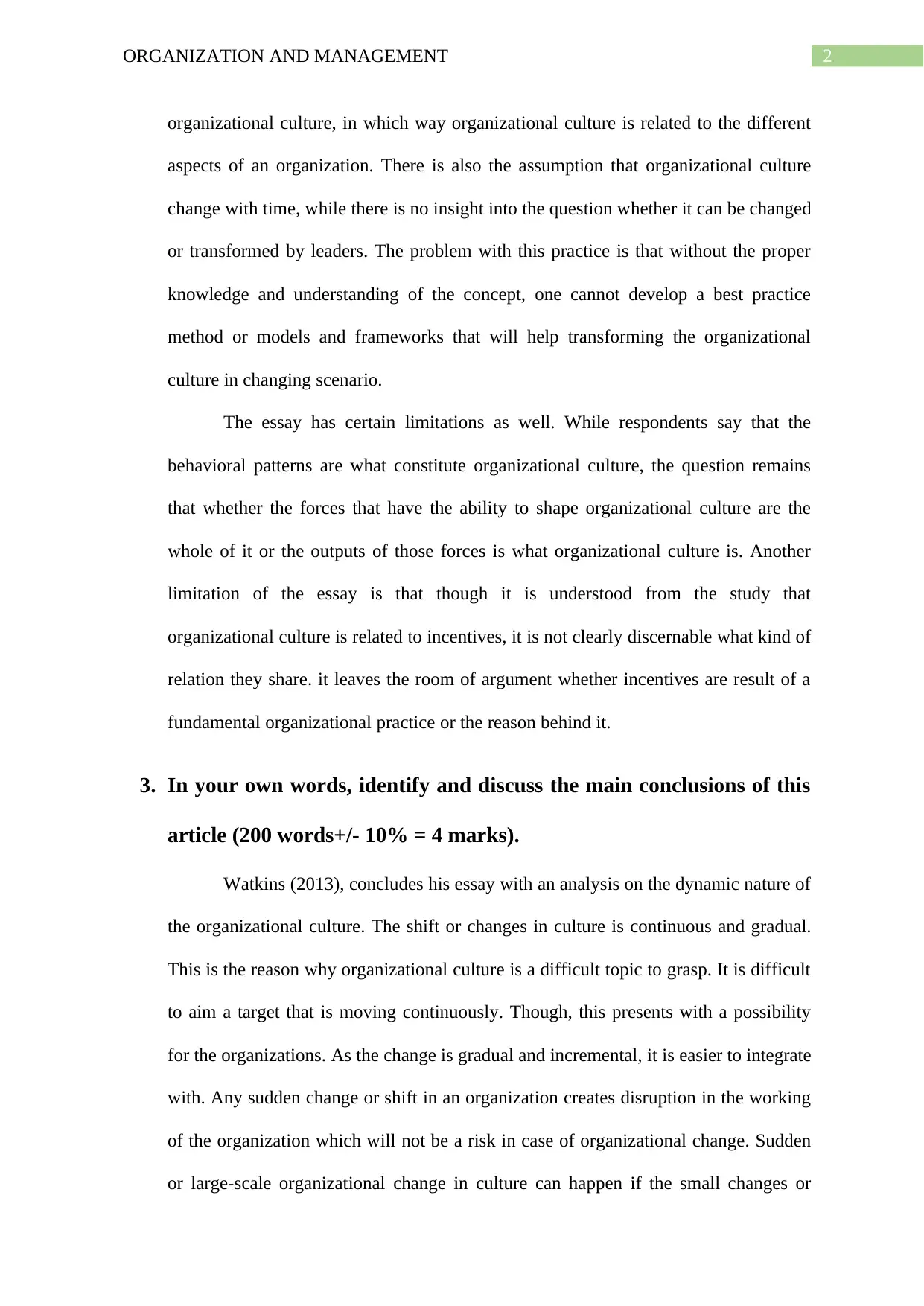
2ORGANIZATION AND MANAGEMENT
organizational culture, in which way organizational culture is related to the different
aspects of an organization. There is also the assumption that organizational culture
change with time, while there is no insight into the question whether it can be changed
or transformed by leaders. The problem with this practice is that without the proper
knowledge and understanding of the concept, one cannot develop a best practice
method or models and frameworks that will help transforming the organizational
culture in changing scenario.
The essay has certain limitations as well. While respondents say that the
behavioral patterns are what constitute organizational culture, the question remains
that whether the forces that have the ability to shape organizational culture are the
whole of it or the outputs of those forces is what organizational culture is. Another
limitation of the essay is that though it is understood from the study that
organizational culture is related to incentives, it is not clearly discernable what kind of
relation they share. it leaves the room of argument whether incentives are result of a
fundamental organizational practice or the reason behind it.
3. In your own words, identify and discuss the main conclusions of this
article (200 words+/- 10% = 4 marks).
Watkins (2013), concludes his essay with an analysis on the dynamic nature of
the organizational culture. The shift or changes in culture is continuous and gradual.
This is the reason why organizational culture is a difficult topic to grasp. It is difficult
to aim a target that is moving continuously. Though, this presents with a possibility
for the organizations. As the change is gradual and incremental, it is easier to integrate
with. Any sudden change or shift in an organization creates disruption in the working
of the organization which will not be a risk in case of organizational change. Sudden
or large-scale organizational change in culture can happen if the small changes or
organizational culture, in which way organizational culture is related to the different
aspects of an organization. There is also the assumption that organizational culture
change with time, while there is no insight into the question whether it can be changed
or transformed by leaders. The problem with this practice is that without the proper
knowledge and understanding of the concept, one cannot develop a best practice
method or models and frameworks that will help transforming the organizational
culture in changing scenario.
The essay has certain limitations as well. While respondents say that the
behavioral patterns are what constitute organizational culture, the question remains
that whether the forces that have the ability to shape organizational culture are the
whole of it or the outputs of those forces is what organizational culture is. Another
limitation of the essay is that though it is understood from the study that
organizational culture is related to incentives, it is not clearly discernable what kind of
relation they share. it leaves the room of argument whether incentives are result of a
fundamental organizational practice or the reason behind it.
3. In your own words, identify and discuss the main conclusions of this
article (200 words+/- 10% = 4 marks).
Watkins (2013), concludes his essay with an analysis on the dynamic nature of
the organizational culture. The shift or changes in culture is continuous and gradual.
This is the reason why organizational culture is a difficult topic to grasp. It is difficult
to aim a target that is moving continuously. Though, this presents with a possibility
for the organizations. As the change is gradual and incremental, it is easier to integrate
with. Any sudden change or shift in an organization creates disruption in the working
of the organization which will not be a risk in case of organizational change. Sudden
or large-scale organizational change in culture can happen if the small changes or
⊘ This is a preview!⊘
Do you want full access?
Subscribe today to unlock all pages.

Trusted by 1+ million students worldwide
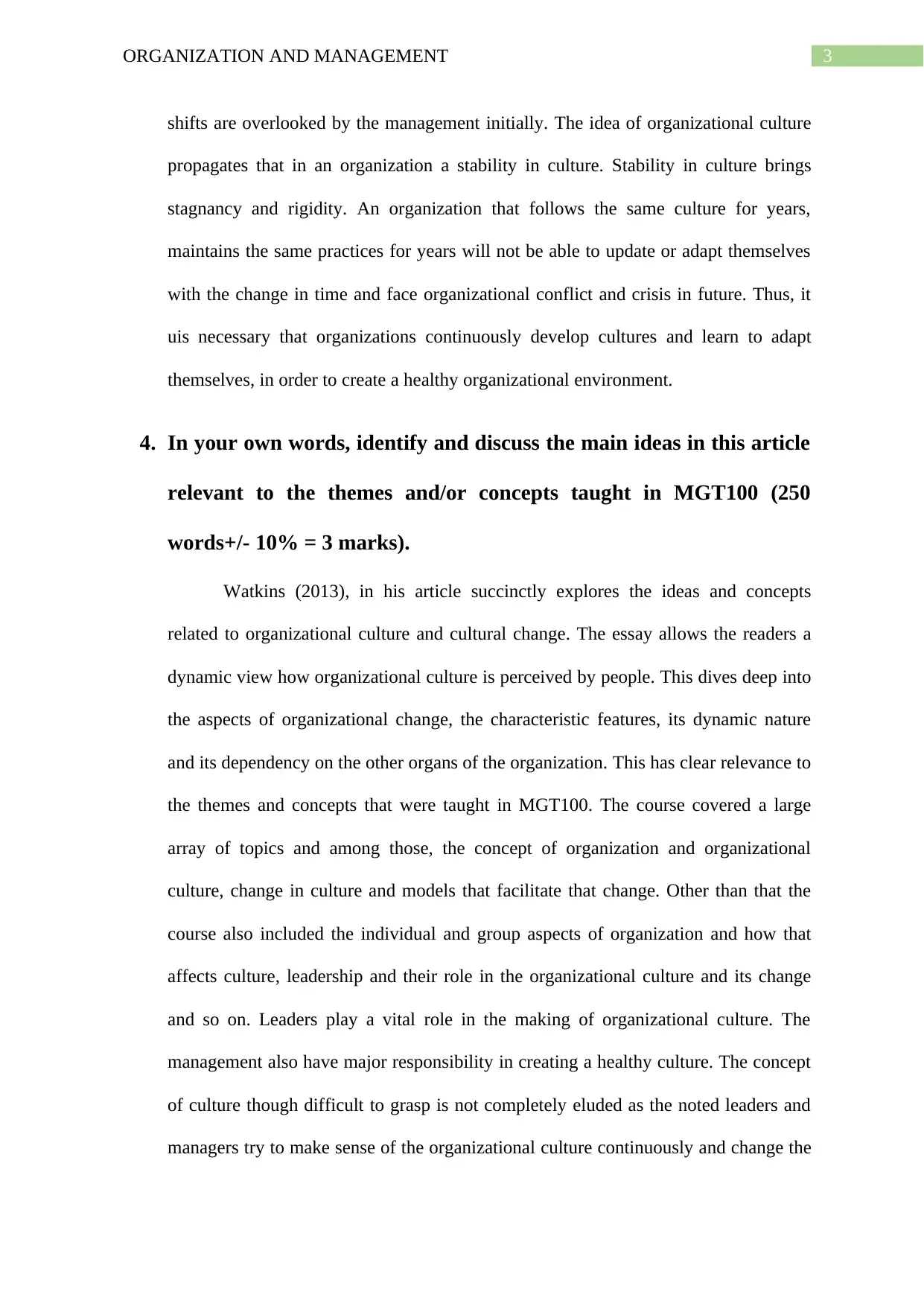
3ORGANIZATION AND MANAGEMENT
shifts are overlooked by the management initially. The idea of organizational culture
propagates that in an organization a stability in culture. Stability in culture brings
stagnancy and rigidity. An organization that follows the same culture for years,
maintains the same practices for years will not be able to update or adapt themselves
with the change in time and face organizational conflict and crisis in future. Thus, it
uis necessary that organizations continuously develop cultures and learn to adapt
themselves, in order to create a healthy organizational environment.
4. In your own words, identify and discuss the main ideas in this article
relevant to the themes and/or concepts taught in MGT100 (250
words+/- 10% = 3 marks).
Watkins (2013), in his article succinctly explores the ideas and concepts
related to organizational culture and cultural change. The essay allows the readers a
dynamic view how organizational culture is perceived by people. This dives deep into
the aspects of organizational change, the characteristic features, its dynamic nature
and its dependency on the other organs of the organization. This has clear relevance to
the themes and concepts that were taught in MGT100. The course covered a large
array of topics and among those, the concept of organization and organizational
culture, change in culture and models that facilitate that change. Other than that the
course also included the individual and group aspects of organization and how that
affects culture, leadership and their role in the organizational culture and its change
and so on. Leaders play a vital role in the making of organizational culture. The
management also have major responsibility in creating a healthy culture. The concept
of culture though difficult to grasp is not completely eluded as the noted leaders and
managers try to make sense of the organizational culture continuously and change the
shifts are overlooked by the management initially. The idea of organizational culture
propagates that in an organization a stability in culture. Stability in culture brings
stagnancy and rigidity. An organization that follows the same culture for years,
maintains the same practices for years will not be able to update or adapt themselves
with the change in time and face organizational conflict and crisis in future. Thus, it
uis necessary that organizations continuously develop cultures and learn to adapt
themselves, in order to create a healthy organizational environment.
4. In your own words, identify and discuss the main ideas in this article
relevant to the themes and/or concepts taught in MGT100 (250
words+/- 10% = 3 marks).
Watkins (2013), in his article succinctly explores the ideas and concepts
related to organizational culture and cultural change. The essay allows the readers a
dynamic view how organizational culture is perceived by people. This dives deep into
the aspects of organizational change, the characteristic features, its dynamic nature
and its dependency on the other organs of the organization. This has clear relevance to
the themes and concepts that were taught in MGT100. The course covered a large
array of topics and among those, the concept of organization and organizational
culture, change in culture and models that facilitate that change. Other than that the
course also included the individual and group aspects of organization and how that
affects culture, leadership and their role in the organizational culture and its change
and so on. Leaders play a vital role in the making of organizational culture. The
management also have major responsibility in creating a healthy culture. The concept
of culture though difficult to grasp is not completely eluded as the noted leaders and
managers try to make sense of the organizational culture continuously and change the
Paraphrase This Document
Need a fresh take? Get an instant paraphrase of this document with our AI Paraphraser
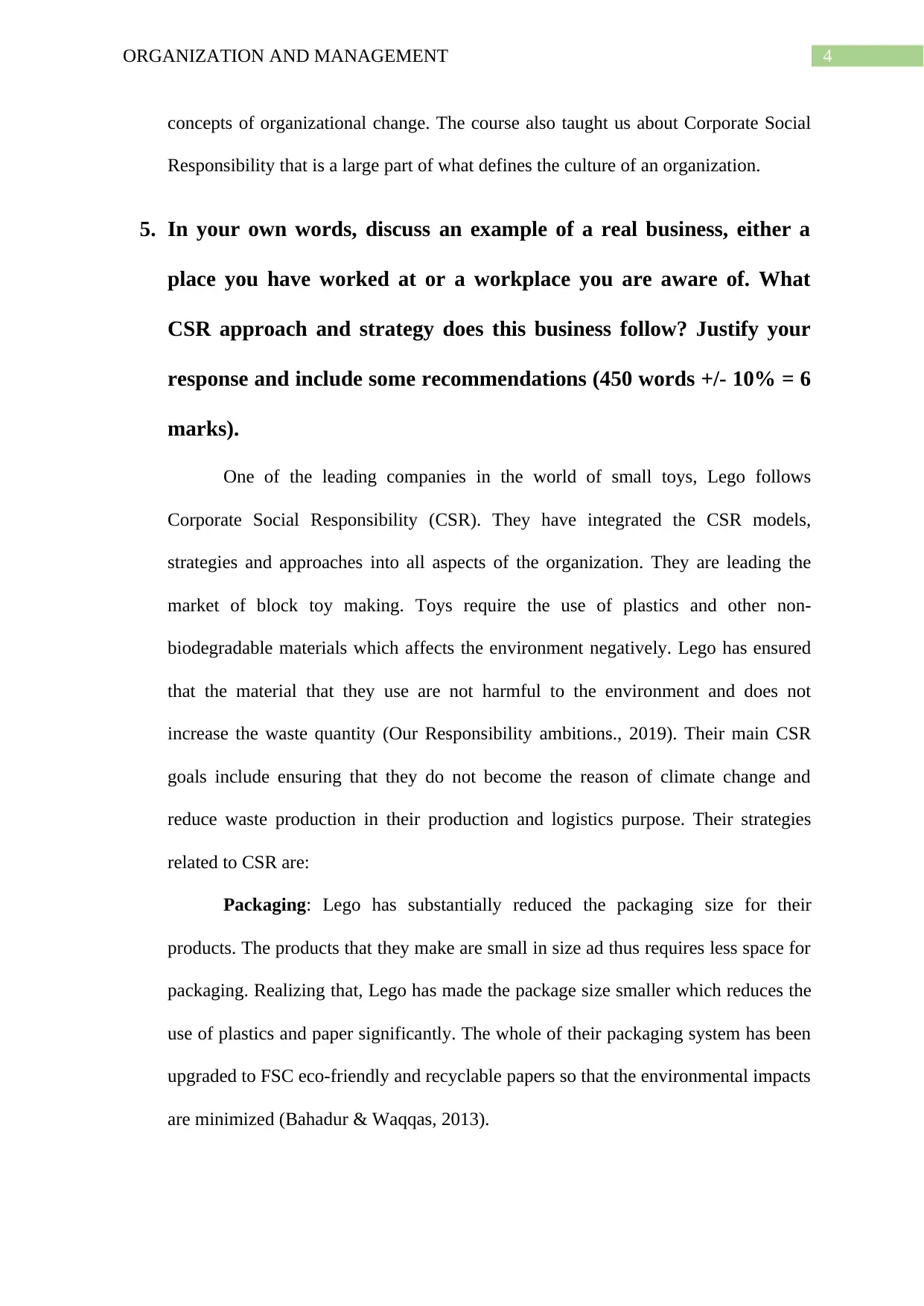
4ORGANIZATION AND MANAGEMENT
concepts of organizational change. The course also taught us about Corporate Social
Responsibility that is a large part of what defines the culture of an organization.
5. In your own words, discuss an example of a real business, either a
place you have worked at or a workplace you are aware of. What
CSR approach and strategy does this business follow? Justify your
response and include some recommendations (450 words +/- 10% = 6
marks).
One of the leading companies in the world of small toys, Lego follows
Corporate Social Responsibility (CSR). They have integrated the CSR models,
strategies and approaches into all aspects of the organization. They are leading the
market of block toy making. Toys require the use of plastics and other non-
biodegradable materials which affects the environment negatively. Lego has ensured
that the material that they use are not harmful to the environment and does not
increase the waste quantity (Our Responsibility ambitions., 2019). Their main CSR
goals include ensuring that they do not become the reason of climate change and
reduce waste production in their production and logistics purpose. Their strategies
related to CSR are:
Packaging: Lego has substantially reduced the packaging size for their
products. The products that they make are small in size ad thus requires less space for
packaging. Realizing that, Lego has made the package size smaller which reduces the
use of plastics and paper significantly. The whole of their packaging system has been
upgraded to FSC eco-friendly and recyclable papers so that the environmental impacts
are minimized (Bahadur & Waqqas, 2013).
concepts of organizational change. The course also taught us about Corporate Social
Responsibility that is a large part of what defines the culture of an organization.
5. In your own words, discuss an example of a real business, either a
place you have worked at or a workplace you are aware of. What
CSR approach and strategy does this business follow? Justify your
response and include some recommendations (450 words +/- 10% = 6
marks).
One of the leading companies in the world of small toys, Lego follows
Corporate Social Responsibility (CSR). They have integrated the CSR models,
strategies and approaches into all aspects of the organization. They are leading the
market of block toy making. Toys require the use of plastics and other non-
biodegradable materials which affects the environment negatively. Lego has ensured
that the material that they use are not harmful to the environment and does not
increase the waste quantity (Our Responsibility ambitions., 2019). Their main CSR
goals include ensuring that they do not become the reason of climate change and
reduce waste production in their production and logistics purpose. Their strategies
related to CSR are:
Packaging: Lego has substantially reduced the packaging size for their
products. The products that they make are small in size ad thus requires less space for
packaging. Realizing that, Lego has made the package size smaller which reduces the
use of plastics and paper significantly. The whole of their packaging system has been
upgraded to FSC eco-friendly and recyclable papers so that the environmental impacts
are minimized (Bahadur & Waqqas, 2013).

5ORGANIZATION AND MANAGEMENT
Product: the product made by Lego ensures that children are able to learn
while playing. Lego recognizes that visual and sensory experiences are better retained
by children and with the use of Lego models and figures children are able to learn
without feeling the burden of studies.
Logistics: the company has made serious attempt in ensuring their role in
minimizing environmental impact. Their logistics partners use sustainable methods
for transporting the supplies and finished products. They also ensure that they use
their manufacturing materials sustainably so that the future generation is able to use
them.
Energy: the company has invested a large amount of money in creating a
alternative source of energy for their functions. With alternative sources like solar and
wind energy, the company has been able to reduce the emissions and impacts on
environment (Isaksson, Kiessling & Harvey, 2014).
Human resource: the organization has ensured that they uphold best ethical
standards and practices in their business. They ensure this by maintaining the labor
rights and human rights. They have plans and policies to protect their employees.
Their recruitment plan also ensure that equality is maintained all over the
organization.
Transparency: the organization ensures to maintain transparency in all their
policies and strategies. All the measures that they take are communicated to their
employees and partners. They have also included stakeholder management and
acquired business partners that also share the same goals and objectives when it
comes to CSR. They focus on long-term goals and alignment with their CSR policies
so that they do not compromise on their values and ethics for short-term profit (Gyrd-
Jones & Kornum, 2013).
Product: the product made by Lego ensures that children are able to learn
while playing. Lego recognizes that visual and sensory experiences are better retained
by children and with the use of Lego models and figures children are able to learn
without feeling the burden of studies.
Logistics: the company has made serious attempt in ensuring their role in
minimizing environmental impact. Their logistics partners use sustainable methods
for transporting the supplies and finished products. They also ensure that they use
their manufacturing materials sustainably so that the future generation is able to use
them.
Energy: the company has invested a large amount of money in creating a
alternative source of energy for their functions. With alternative sources like solar and
wind energy, the company has been able to reduce the emissions and impacts on
environment (Isaksson, Kiessling & Harvey, 2014).
Human resource: the organization has ensured that they uphold best ethical
standards and practices in their business. They ensure this by maintaining the labor
rights and human rights. They have plans and policies to protect their employees.
Their recruitment plan also ensure that equality is maintained all over the
organization.
Transparency: the organization ensures to maintain transparency in all their
policies and strategies. All the measures that they take are communicated to their
employees and partners. They have also included stakeholder management and
acquired business partners that also share the same goals and objectives when it
comes to CSR. They focus on long-term goals and alignment with their CSR policies
so that they do not compromise on their values and ethics for short-term profit (Gyrd-
Jones & Kornum, 2013).
⊘ This is a preview!⊘
Do you want full access?
Subscribe today to unlock all pages.

Trusted by 1+ million students worldwide
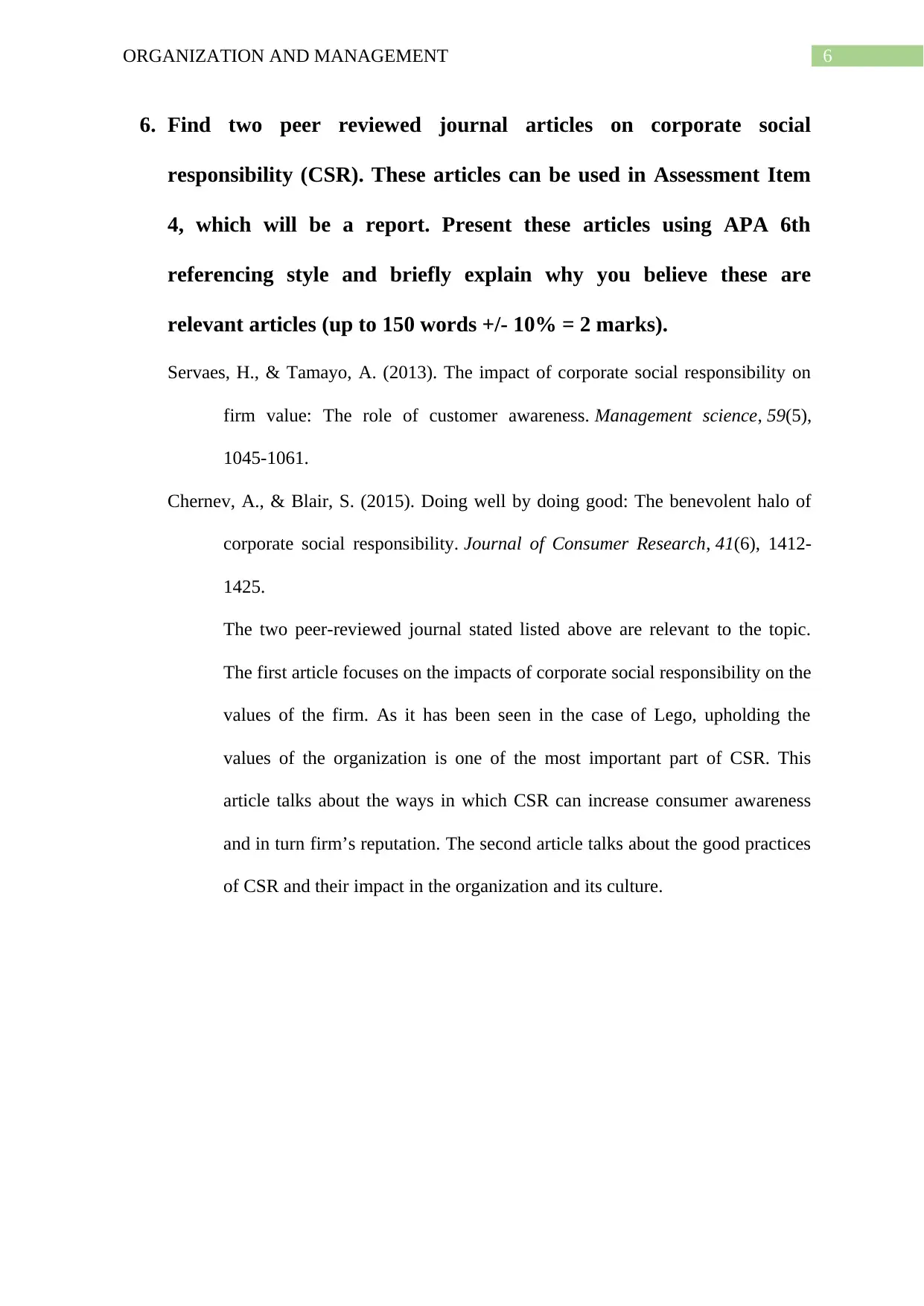
6ORGANIZATION AND MANAGEMENT
6. Find two peer reviewed journal articles on corporate social
responsibility (CSR). These articles can be used in Assessment Item
4, which will be a report. Present these articles using APA 6th
referencing style and briefly explain why you believe these are
relevant articles (up to 150 words +/- 10% = 2 marks).
Servaes, H., & Tamayo, A. (2013). The impact of corporate social responsibility on
firm value: The role of customer awareness. Management science, 59(5),
1045-1061.
Chernev, A., & Blair, S. (2015). Doing well by doing good: The benevolent halo of
corporate social responsibility. Journal of Consumer Research, 41(6), 1412-
1425.
The two peer-reviewed journal stated listed above are relevant to the topic.
The first article focuses on the impacts of corporate social responsibility on the
values of the firm. As it has been seen in the case of Lego, upholding the
values of the organization is one of the most important part of CSR. This
article talks about the ways in which CSR can increase consumer awareness
and in turn firm’s reputation. The second article talks about the good practices
of CSR and their impact in the organization and its culture.
6. Find two peer reviewed journal articles on corporate social
responsibility (CSR). These articles can be used in Assessment Item
4, which will be a report. Present these articles using APA 6th
referencing style and briefly explain why you believe these are
relevant articles (up to 150 words +/- 10% = 2 marks).
Servaes, H., & Tamayo, A. (2013). The impact of corporate social responsibility on
firm value: The role of customer awareness. Management science, 59(5),
1045-1061.
Chernev, A., & Blair, S. (2015). Doing well by doing good: The benevolent halo of
corporate social responsibility. Journal of Consumer Research, 41(6), 1412-
1425.
The two peer-reviewed journal stated listed above are relevant to the topic.
The first article focuses on the impacts of corporate social responsibility on the
values of the firm. As it has been seen in the case of Lego, upholding the
values of the organization is one of the most important part of CSR. This
article talks about the ways in which CSR can increase consumer awareness
and in turn firm’s reputation. The second article talks about the good practices
of CSR and their impact in the organization and its culture.
Paraphrase This Document
Need a fresh take? Get an instant paraphrase of this document with our AI Paraphraser
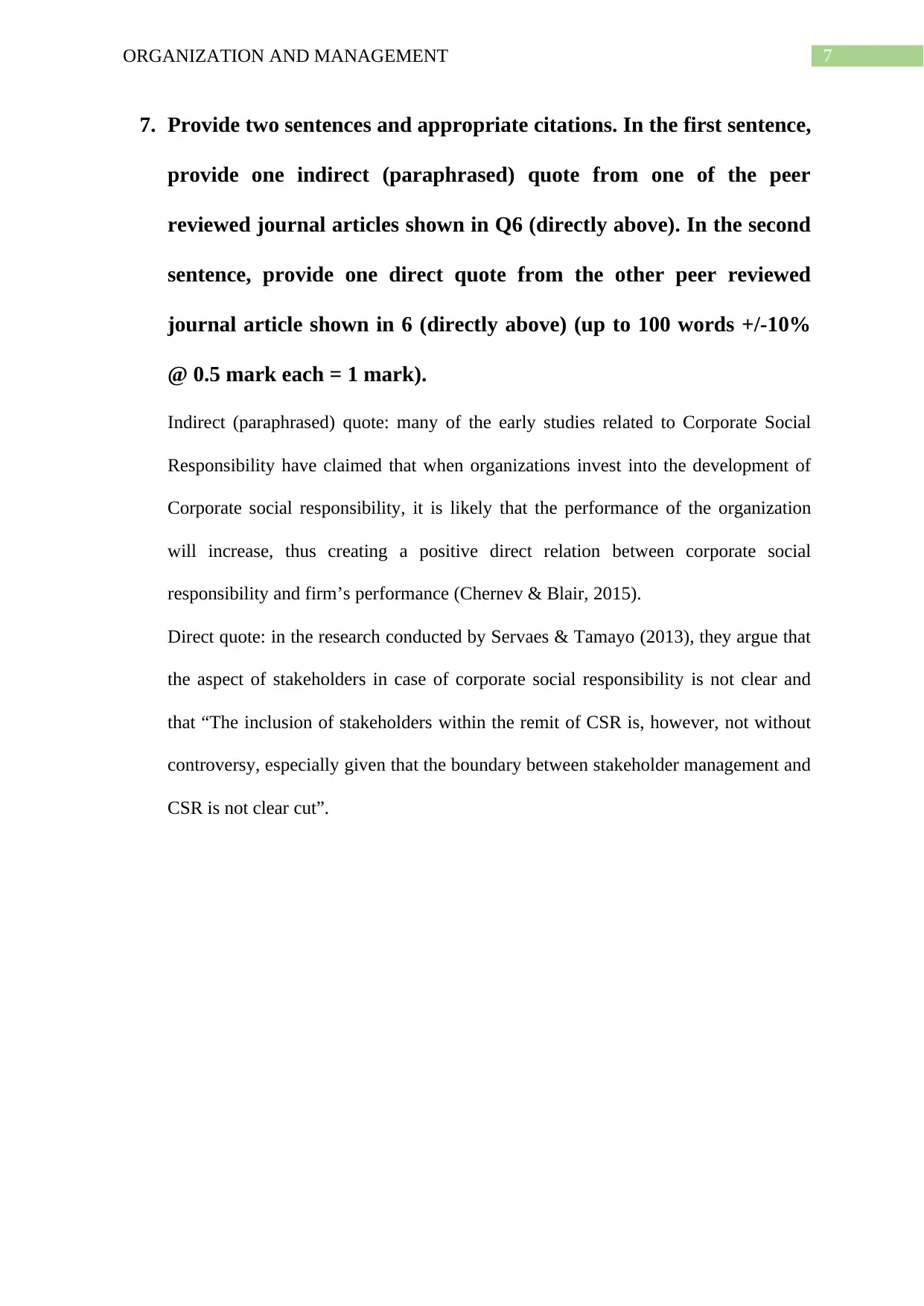
7ORGANIZATION AND MANAGEMENT
7. Provide two sentences and appropriate citations. In the first sentence,
provide one indirect (paraphrased) quote from one of the peer
reviewed journal articles shown in Q6 (directly above). In the second
sentence, provide one direct quote from the other peer reviewed
journal article shown in 6 (directly above) (up to 100 words +/-10%
@ 0.5 mark each = 1 mark).
Indirect (paraphrased) quote: many of the early studies related to Corporate Social
Responsibility have claimed that when organizations invest into the development of
Corporate social responsibility, it is likely that the performance of the organization
will increase, thus creating a positive direct relation between corporate social
responsibility and firm’s performance (Chernev & Blair, 2015).
Direct quote: in the research conducted by Servaes & Tamayo (2013), they argue that
the aspect of stakeholders in case of corporate social responsibility is not clear and
that “The inclusion of stakeholders within the remit of CSR is, however, not without
controversy, especially given that the boundary between stakeholder management and
CSR is not clear cut”.
7. Provide two sentences and appropriate citations. In the first sentence,
provide one indirect (paraphrased) quote from one of the peer
reviewed journal articles shown in Q6 (directly above). In the second
sentence, provide one direct quote from the other peer reviewed
journal article shown in 6 (directly above) (up to 100 words +/-10%
@ 0.5 mark each = 1 mark).
Indirect (paraphrased) quote: many of the early studies related to Corporate Social
Responsibility have claimed that when organizations invest into the development of
Corporate social responsibility, it is likely that the performance of the organization
will increase, thus creating a positive direct relation between corporate social
responsibility and firm’s performance (Chernev & Blair, 2015).
Direct quote: in the research conducted by Servaes & Tamayo (2013), they argue that
the aspect of stakeholders in case of corporate social responsibility is not clear and
that “The inclusion of stakeholders within the remit of CSR is, however, not without
controversy, especially given that the boundary between stakeholder management and
CSR is not clear cut”.
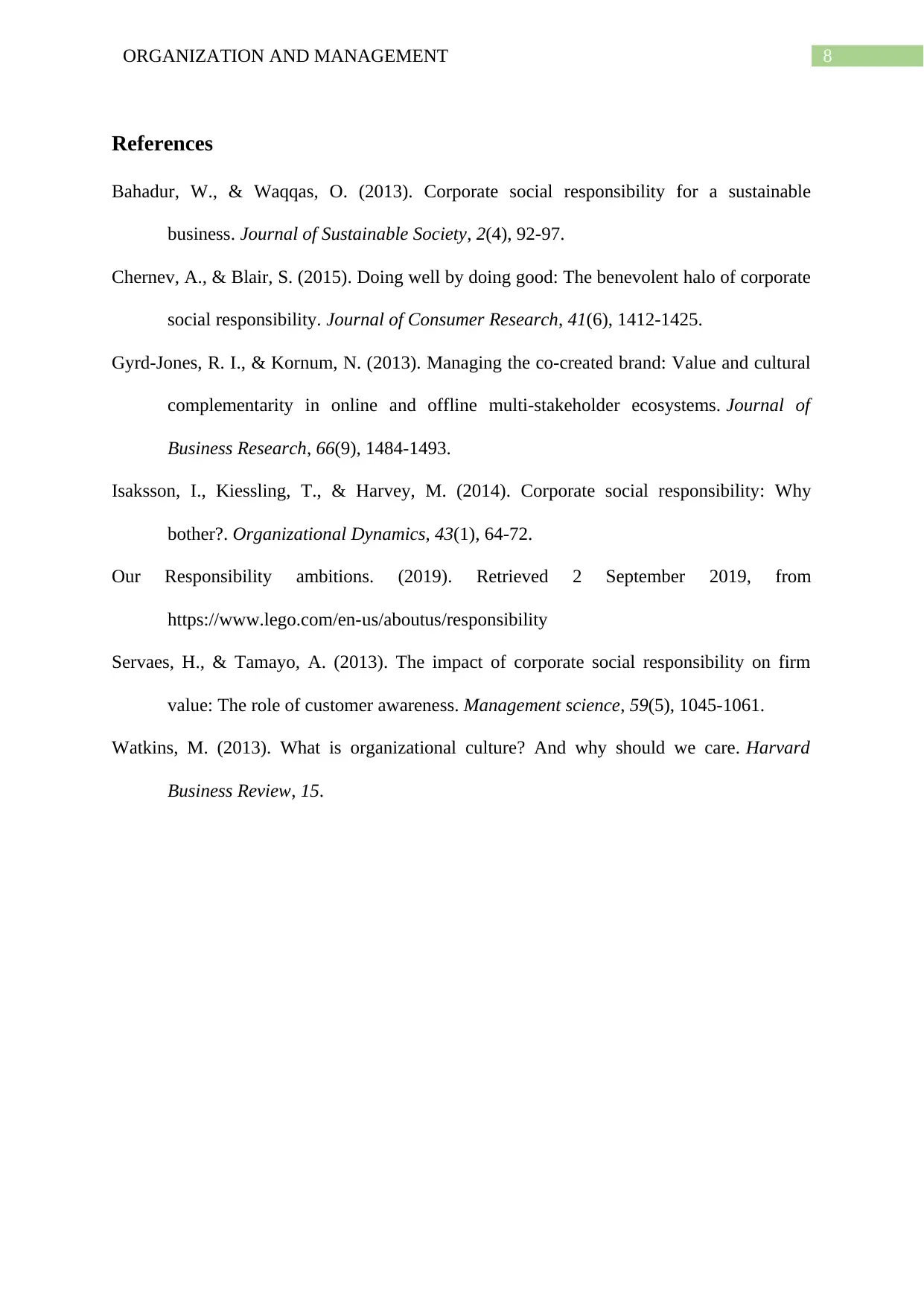
8ORGANIZATION AND MANAGEMENT
References
Bahadur, W., & Waqqas, O. (2013). Corporate social responsibility for a sustainable
business. Journal of Sustainable Society, 2(4), 92-97.
Chernev, A., & Blair, S. (2015). Doing well by doing good: The benevolent halo of corporate
social responsibility. Journal of Consumer Research, 41(6), 1412-1425.
Gyrd-Jones, R. I., & Kornum, N. (2013). Managing the co-created brand: Value and cultural
complementarity in online and offline multi‐stakeholder ecosystems. Journal of
Business Research, 66(9), 1484-1493.
Isaksson, I., Kiessling, T., & Harvey, M. (2014). Corporate social responsibility: Why
bother?. Organizational Dynamics, 43(1), 64-72.
Our Responsibility ambitions. (2019). Retrieved 2 September 2019, from
https://www.lego.com/en-us/aboutus/responsibility
Servaes, H., & Tamayo, A. (2013). The impact of corporate social responsibility on firm
value: The role of customer awareness. Management science, 59(5), 1045-1061.
Watkins, M. (2013). What is organizational culture? And why should we care. Harvard
Business Review, 15.
References
Bahadur, W., & Waqqas, O. (2013). Corporate social responsibility for a sustainable
business. Journal of Sustainable Society, 2(4), 92-97.
Chernev, A., & Blair, S. (2015). Doing well by doing good: The benevolent halo of corporate
social responsibility. Journal of Consumer Research, 41(6), 1412-1425.
Gyrd-Jones, R. I., & Kornum, N. (2013). Managing the co-created brand: Value and cultural
complementarity in online and offline multi‐stakeholder ecosystems. Journal of
Business Research, 66(9), 1484-1493.
Isaksson, I., Kiessling, T., & Harvey, M. (2014). Corporate social responsibility: Why
bother?. Organizational Dynamics, 43(1), 64-72.
Our Responsibility ambitions. (2019). Retrieved 2 September 2019, from
https://www.lego.com/en-us/aboutus/responsibility
Servaes, H., & Tamayo, A. (2013). The impact of corporate social responsibility on firm
value: The role of customer awareness. Management science, 59(5), 1045-1061.
Watkins, M. (2013). What is organizational culture? And why should we care. Harvard
Business Review, 15.
⊘ This is a preview!⊘
Do you want full access?
Subscribe today to unlock all pages.

Trusted by 1+ million students worldwide
1 out of 9
Related Documents
Your All-in-One AI-Powered Toolkit for Academic Success.
+13062052269
info@desklib.com
Available 24*7 on WhatsApp / Email
![[object Object]](/_next/static/media/star-bottom.7253800d.svg)
Unlock your academic potential
Copyright © 2020–2025 A2Z Services. All Rights Reserved. Developed and managed by ZUCOL.





